Indoor gardening offers a delightful way to bring nature inside while requiring minimal effort. Discovering low-maintenance plants perfect for indoor environments can transform your living space into a green haven.
Introduction to Low-Maintenance Indoor Plants
In today's fast-paced world, the appeal of low-maintenance indoor plants lies in their ability to thrive with minimal care, enhancing interior spaces and well-being.
Leafy Greens Perfect for Indoor Cultivation
Spider plants, pothos, and peace lilies are resilient leafy greens that effortlessly adapt to indoor conditions, making them ideal choices for novice indoor gardeners.
Succulents and Cacti for Easy Indoor Care
Aloe vera, jade plants, and snake plants, known for their adaptability and ability to thrive in arid conditions, require little attention and are excellent choices for indoor settings.
Air-Purifying Plants Suitable for Indoors
Rubber plants, snake plants, and peace lilies are not only low-maintenance but also effective in purifying indoor air, enhancing the overall indoor environment.
Flowering Plants that Require Minimal Attention
Orchids, African violets, and begonias are aesthetically pleasing flowering plants that, with the right care, grace indoor spaces with their blooms without demanding excessive care.
Adaptable Herbs for Indoor Growing
Basil, mint, and parsley are versatile herbs that flourish indoors, providing fresh flavors while adding greenery to indoor settings.
Conclusion
Low-maintenance indoor plants offer an excellent opportunity for enhancing your living space with greenery while requiring minimal effort. Embrace these plants to create a refreshing and calming indoor oasis.
FAQs about Low-Maintenance Indoor Plants
- How often should I water low-maintenance indoor plants?
- Which low-maintenance plants thrive best in low-light conditions?
- Can I use regular potting soil for indoor plants?
- What are the ideal temperatures for indoor plants?
- How do I prevent common pests in indoor gardening?


Your writing style is so engaging!
ReplyDelete